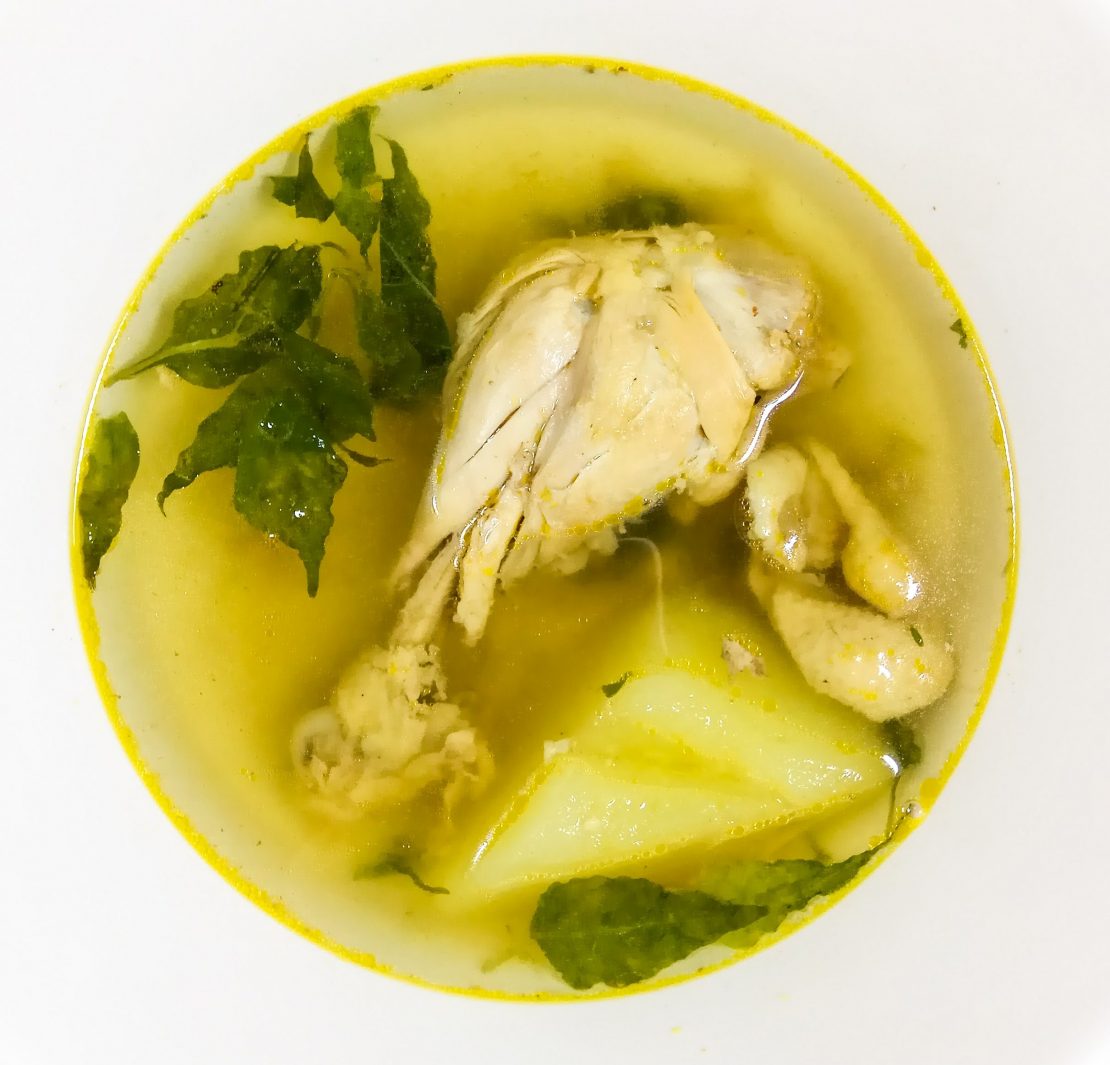There are a few non-negotiables in my tinola. There has to be dahon sili, even though one can hardly taste what difference it makes. I don’t mind if it’s green papaya or sayote as long as there is something other than the chicken (or the ginger by mistake) to chew on. (In our household, we also add cabbage for more chewing pleasure, and to extend the amount of chicken we have.) I do find that near-ripe papaya adds a nice sweetness to the broth, so I strive to find that pale orange but firm fruit in the market. Malunggay is a welcome addition as long as the leaves are plucked off neatly without the hardened stems, and as long as no neighbor is left to wonder what happened to their dear tree. Ginger is essential but too much can overwhelm the palate of an unsuspecting ginger-neutral eater. But I love it anyway. I’d saute the chicken in julienned ginger, and for good measure, add in a pounded whole piece right before letting it simmer. It’s soothing with its mildly spicy and peppery flavor cutting through the richness of the broth.
One will often argue against this “plain” soup. I don’t blame them. Being a rice-eating nation, we are used to bold broths and stews to accompany the blank slate that is a bed of steamed rice. Tinola’s allure then lies in the subtle, barely-there flavor that warrants many consecutive sips of its warm, sweet, peppery, and rich soup before one fully gets it.
Unlike the much-loved sinigang, it depends not on another ingredient to build a distinct taste. It relies solely on the chicken. The rest are barely accompaniments to the lead instrument. They are put there not to do what sampalok does to the sinigang or what suka and toyo do to adobo. They are all unassuming, earnest, content in what little flavor they can add. They are but team players in the sport that is brewing together a mild broth that is tinola.
In some kitchens, cooks go to lengths such as sourcing native chicken for a more robust flavor. The method of sauteing itself is there to lock in these flavors inside the meat and to render as much fat as possible. It is then left to simmer to release more of its essence into the broth.
[READ: Banli, busa, sangkutsa, and other essential Filipino cooking terms you need to know]Ah, the broth! It’s what carries the burden of this dish, a product of a patient and calculated stewing that loosens the meat off its bones, breaks off its tendons. Readily-made broth or cubes can shorten the cooking time without compromising flavor. But still, adequate time is needed to make the chicken pieces just tender enough.
Tinola’s allure then lies in the subtle, barely-there flavor that warrants many consecutive sips of its warm, sweet, peppery, and rich soup before one fully gets it.
After the chicken, the next vital ingredient, in my opinion (I have to make this disclaimer as food is ultimately subjective), is patis. Not the sawsawan that tinola non-believers run to to avoid implying blandness in their mothers’ or helpers’ pot, but the one that is added when cooking in lieu of or to support salt. Salt is fine. But with tinola, just saltiness will not cut it. Patis is potent. Other than salt, it is fish; it is umami. It imbues anything with flavor as one pours it from a transparent bottle that reveals its deep amber color. A few drops are divine, but too much, much like salt, can be irreversible. One needs to pause one’s storytelling in the kitchen when pouring patis lest they risk ruining what is otherwise a perfectly okay dish.
Tinola reminds me of many things. The sauteing part, the start of making lugaw or arroz caldo, if you please. The rendering of the chicken fat against the backdrop of aromatics always sends me to the kitchen just to check if my mother or lola or sibling is indeed making lugaw or is in fact beginning to prepare tinola—oftentimes against their wishes. Munching on the verdant green leaves of chili and malunggay takes me back to moments before mealtime in our neighbors’ door, wooing them to let me pick those fresh from their gardens. The watchful eyes linger to make sure I don’t take all the good parts and leave enough if they themselves decide to make tinola for their own families, using their own recipes.
Contrary to this piece’s title, I can’t for the love of this dish force someone to like it as much as I do. Tinola itself asserts nothing. It is not a crowd-pleaser, it is at best a weekday ulam best enjoyed among family. Jose Rizal, who wrote of tinola in his book “Noli Me Tangere” as a meal fit for hosting, will likely fight me on this. In the book, the dish is imbued with so much symbolism—or at least the parts of the chicken were. Tinola, for all its contested plainness, is a battleground and is happy to be it. Otherwise, what will we be talking about it other than “Is this chicken or a big piece of ginger?” Please.




